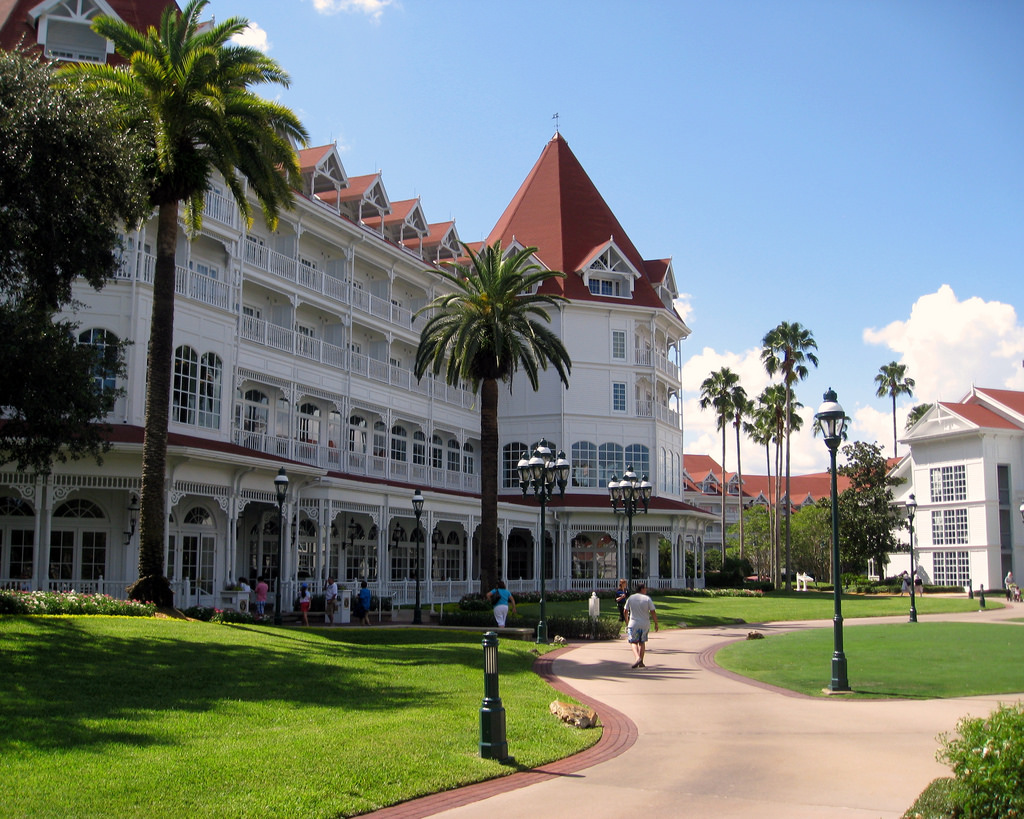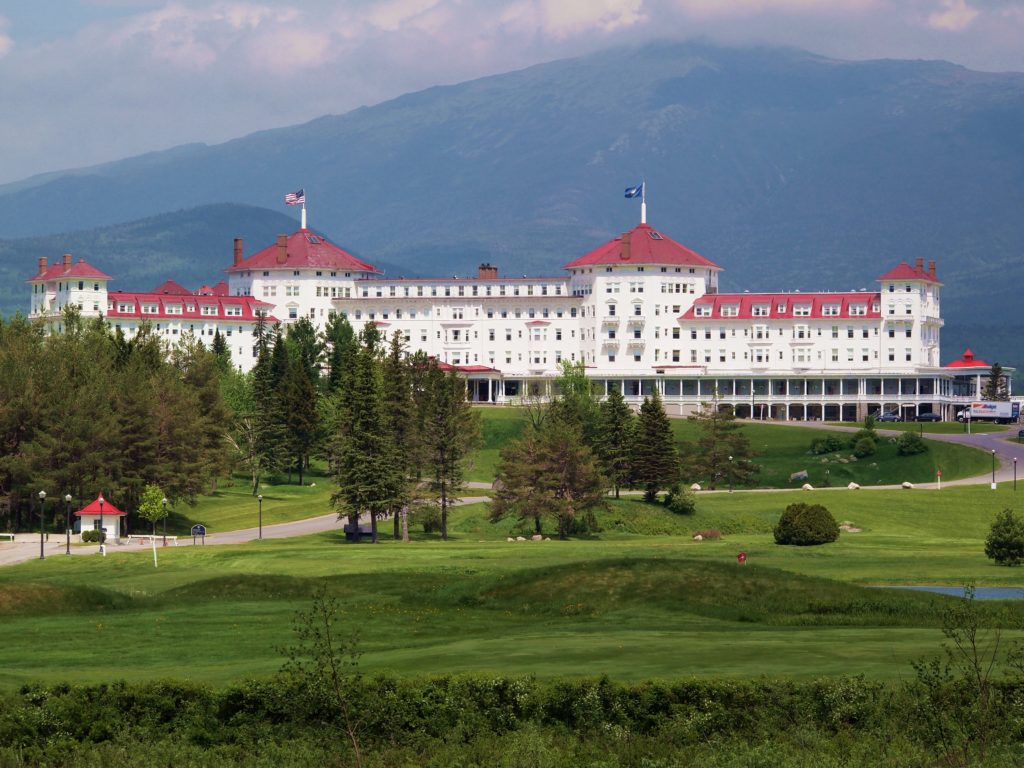
For many, the Grand Floridian represents the very best of Disney resort hotels. The Mary Poppins-themed topiaries, pinstriped hotel staff, and classic English tea room delight visitors new and old. Its white-trimmed Victorian splendor greets guests the moment they arrive and presents an obvious continuation of their experience on Main Street, USA. So, just where did the hotel’s design originate? Where are the real places that inspired Disney’s Grand Floridian Resort?
Many towns across America offer fine examples of Victorian architecture, but the Grand Floridian reflects a special subset of this style. Its primary antecedent was the once-ubiquitous turn-of-the-century seaside resort. A few of these live on as real places
Newport Beach-based architecture firm Wimberly, Alison, Tong & Goo executed the design alongside Disney’s in-house architects. The firm set out to design a hotel that would evoke the nostalgic charm of the Victorian seaside resort. However, just like buildings from this period, the Grand Floridian is not true to one particular style. (Victorians were not known for stylistic coherence–more on that in our Cape May post). Design partner Gerald Allison described the style as “American Victorian, basically the Queen Anne style.” (Dunlop, p. 109). “Basically” is the important word there. The Grand Floridian drew from a number of distinct hotels across the country for its design and character.
Fortunately for Grand Floridian fans, a few of these places are still around today and are ready for your visit. These hotels managed to survive fires, hurricanes, and redevelopment attempts and continue to offer guests a sense of the grandeur that was once the Victorian seaside hotel. Follow along for a tour of the real places that inspired Disney’s Grand Floridian Resort.
Hotel del Coronado, Coronado, California

Photo courtesy of Wikipedia
This famous San Diego resort was the primary inspiration for the Grand Floridian’s exterior. Affectionately known as “the Del,” the Hotel del Coronado features a conspicuous red roof and sprawling white complex that you’ll recognize instantly.
The Del debuted in 1888 to great fanfare, just across the bay from San Diego proper. At the time, it was the largest resort hotel in the world and would be the largest electrified building when it underwent that transformation. Today, it holds the record for second-largest wooden structure in the United States. It is, in fact, one of the last surviving examples of a once-prominent American architectural genre: the wooden seaside resort.
The Del has hosted countless dignitaries and celebrities over the years, and continues to offer guests an elegant experience in southern California. For more on the hotel’s history, including information on daily docent-led tours, visit the Del’s interactive historical timeline.
Gasparilla Inn & Club, Gasparilla Island, Florida

Photo courtesy of Wikipedia
The Gasparilla Inn & Club on Boca Grande stands out as one of only two Florida hotels on this Grand Floridian-inspired list. You might recognize the name from one of the Grand Floridian’s restaurants–the Gasparilla Island Grill. This quick-service restaurant is open 24/7, and while its look has changed over time following a series of renovations, it’s retained its light and airy feel, with pale greens and bronze fixtures reminiscent of a Florida palm house.
Like many resort areas from the period, the real Gasparilla Inn’s story is intertwined with that of the railroad. In the early 1900s, the American Agricultural Chemical Company was shipping the valuable chemical phosphate, a key ingredient in fertilizer, from southwest Florida by barge. Recognizing the efficiencies to be gained from shipping product by rail, the company established two subsidiaries–one, the Charlotte Harbor and Northern Railroad and two, the Boca Grande Land Company.
At the same time, tarpon fishing drew wealthy northern visitors to the area, made much more accessible by train. Seeing the opportunity, the Land Company began work on a resort in 1909 and in 1911, the Inn opened as “The Hotel Boca Grande.” Almost immediately, locals began opening shops and businesses around the hotel and the railroad brought car-fulls of northerners.
In light of the hotel’s success, the developers sought to expand the simple original structure. In 1912, they hired well-known Florida architect Francis Kennard to design an expansion, and it was during this time that the hotel’s distinguishable Queen Anne elements began to appear. The developers shipped polished new furnishings from Wanamaker’s in New York, and the the hotel as we know it today came to be. The expanded hotel opened for the 1913 season under its new moniker, “The Gasparilla Inn.”
When you visit, don’t miss the 1910 train depot down the street from the Inn. Located on the corner of Park Avenue and Fourth Street, the historic depot has been restored as a mixed-use building, with The Loose Caboose Restaurant occupying its south end. Stop by for a grouper sandwich or their acclaimed homemade ice cream before settling in at our #2 stop among the real places that inspired Disney’s Grand Floridian Resort.
Omni Mount Washington Resort, Bretton Woods, New Hampshire

Photo courtesy of Wikimedia Commons
Although not a seaside resort, there’s no questioning the Omni Mount Washington‘s connection to the Grand Floridian with its bright white facade and red roof.
The creation of New York financier Joseph Stickney, the Mount Washington Hotel came to life in 1902 after two years of construction efforts by 250 Italian craftsmen. Despite its location tucked away in the White Mountains of New Hampshire, the hotel operated for several decades as a a summer-only destination. Guests enjoyed the well-designed golf course, wagon rides, billiards games, the indoor swimming pool, and many other amenities, all quite modern for the time.
The hotel changed hands multiple times throughout the 20th century, playing its most famous role as host to the 1944 Bretton Woods Monetary Conference. It was during this conference that the UN established the World Bank and International Monetary Fund in an effort to address the global economic consequences of World War II. As a result of the conference, the hotel benefited from a number of renovations sponsored by the U.S. government and earned its name in the history books.
In the 1990’s, several New Hampshire businessmen bought up both the hotel and surrounding tracts of land to consolidate into what is now the state’s largest ski area. Today, the hotel operates as an Omni property, is open for year-round stays, and is #3 on our list of real places that inspired Disney’s Grand Floridian Resort.
Grand Hotel, Mackinac Island, Michigan

Photo courtesy of Wikimedia Commons
Don’t let this hotel’s remote location dissuade you–the Grand Hotel on Mackinac Island, Michigan has served as a real-life celebration of Victorian resort style since its founding in 1887. Not unlike the other hotels on this list, it was a consortium of transportation companies that would come together to invest in a resort property. Developers marketed the Grand Hotel as a welcome summer respite for vacationers who arrived by steamship from Chicago, Detroit, Erie and Montreal and by rail from other parts of the country. Today, the resort still boasts the superlative of longest porch in the country, from which visitors can take in sweeping views of Lake Huron little changed from earlier times.
Fans of Victoriana are in good company at the Grand Hotel. The resort enjoys repeat guests, many of whom travel specifically to savor the island’s Victorian legacy. Indeed, the hotel was front-and-center in American public life in the 1890’s. Thomas Edison conducted his first public demonstration of the phonograph on the famous porch, and Mark Twain often included the Grand Hotel on his Midwest speaking circuit.
By the 1980’s, this legacy was far from forgotten, when the the hotel served as filming location for the movie, Somewhere in Time. Visitors trek to the hotel annually to celebrate the cult film, in which Christopher Reeves’ character travels back in time in search of his 1912 soulmate (played by Jane Seymour). A dashing Christopher Plummer portrays hotel manager and adversary to the couple’s romantic aspirations. What’s not to love?
The Belleview Inn, Belleair, Florida

Photo courtesy of Flickr

The Belleview Inn today lives on as a reincarnation of its former self. Known originally as the Belleview-Biltmore, the hotel was constructed in Bellair, Florida in 1897, overlooking Clearwater Bay on Florida’s west coast. The hotel owed its existence to railroad tycoon Henry Plant, who, like his counterpart Henry Flagler on the east coast, was responsible for bringing the railroad and spurring development on Florida’s west coast. The Belleview was only one of several grand hotels that Plant built throughout Florida.
Over time, the hotel changed hands, experienced varying levels of upkeep, and dodged the wrecking ball repeatedly. Most recently, a team of developers led a three-year renovation which preserved part of the sprawling original structure. In 2018, the hotel opened as the Belleview Inn and includes the original lobby and surrounding 35 guest rooms. Fortunately, the developers executed a carefully-planned demolition process for the remaining building, salvaging original materials for reuse in the new building. These include the resplendent stained-glass panels that now grace the ceiling of the recreated “Tiffany Room.” Despite losing its designation on the U.S. National Register of Historic Places, “the Queen of the Gulf” lives on as a tribute to the golden age of Florida travel.
The Brown Palace Hotel, Denver, Colorado

Photo courtesy of Wikimedia Commons
You might be thinking, what’s a Colorado-based hotel doing on a list of hotels that inspired the Grand Floridian?
Although not a seaside resort, The Brown Palace Hotel in Denver served as the model for the Grand Floridian’s atrium lobby. Eight floors of cast-iron balconies, topped by a stained glass ceiling, comprise the Denver hotel’s lobby. Sound familiar?
In operation since 1892, the Brown Palace Hotel today hosts guests as part of Marriott’s Autograph Collection of hotels. Stop by next time you’re in Denver to visit #6 on our list of the real places that inspired Disney’s Grand Floridian Resort.
Viewpoints expressed reflect the personal opinions and views of the author. They do not reflect the views of any other entity and should not be read to endorse or otherwise promote any person, business, or service.
